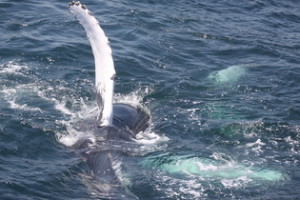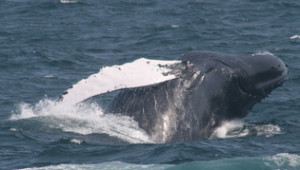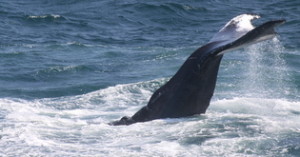Dolphin Fleet Naturalist Notebook – 24 July to 30 July
On July 24th, our naturalist, Gwen, writes, “Today we headed again to the triangle. We saw more tuna today than I ever have before. We passed one or two Minke whales and stayed with two humpbacks for a few minutes until they took a very deep dive. Then, we ventured to the northeast of the triangle. There, we met up with approximately six humpback whales, including the wonderful group of familiar fins, including Cajun and her calf, Pele, Alphorn and Milkweed.”
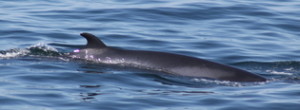
On the 4pm trip, Gwen writes, “We headed directly to the northeast portion of the Triangle, where we spent the entire trip with a group of eight whales, including Cajun and calf, Firefly and calf, Alphorn, Pele, Milkweed, and one unidentified individual. The calves spent the majority of the time at the surface while the adults kept making dives of about 3-6 minute intervals. By the time we were ready to depart, a ninth humpback came and joined the group. As we left, we saw one breach as a finale to a great trip!”
Passengers aboard the Portuguese Princess II on the afternoon of July 25th enjoyed an exciting start to their trip with a humpback whale named Skateboard who was breaching and flipper slapping right by the boat! We don’t know why whales do this, but we think that it might be a signal to other whales in the area.
Meanwhile, aboard the Dolphin VII, the morning trip saw three different species of baleen whales. In addition to the always exciting humpback whales, Minkes, and even an enormous fin whale were spotted just east of Stellwagen Bank. We finished up the afternoon with a close approach from a humpback named Bandit. Bandit has a mask-like pattern on his dorsal flukes, giving him his moniker. Bandit is famous for his spastic feeding style in which is twists and contorts his tail before wildly slapping the water in order to corral and stun fish. While we didn’t see that behavior today, we did get a great look at this large humpback as he swam up along side the Dolphin VII!
July 26th was windy, with choppy seas throughout the day. We still managed to get great looks at a number of humpback whales, including Midnight and her calf. We have been watching Midnight since 1979 and this is her eighth calf to date. Midnight can be recognized by her nearly all-black fluke and her tiny dorsal fin.
Today we also noticed a change in group dynamics among some of our humpbacks. For the past few weeks, Cajun and her calf have been accompanied by Alphorn, Pele, and Milkweed, but today, these whales were traveling together with Cajun and the calf nowhere in sight! It is typical for humpback whales groups to merge and split without any warning, and it is exciting to observe the fusion and diffusion of these groups and wonder about the reasons behind it!
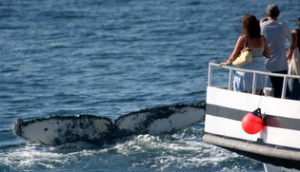
By July 27th the winds had died down enough to enjoy a smooth ride out to eastern Stellwagen Bank. Throughout the morning trip, we kept seeing frantic splashing at the surface of the water. A sure sign of bluefin tuna. Although stocks of this amazing fish are declining worldwide, we’ve had great sightings of tuna throughout July.
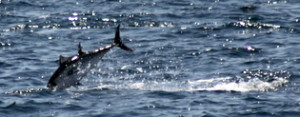
In the afternoon, more humpbacks started to move into the area. We watched Geometry, a 13 year old male, blow a perfect spiral of bubbles. This behavior is suggestive of feeding, as humpbacks will use bubble nets to trap and corral fish. Curiously, we did not see this whale start to feed. Instead, Geometry abandoned the bubbles and started to flipper slap!
On the sunset trip, we watched as groups merged and broke up again. Pele, Alphorn, Milkweed, and an unknown individual swam together. Ventisca, a large female with a distinct white dorsal fin, seemed to be chasing the group, wanting to join; however, she never caught up. The unidentified individual from the group soon broke off on its own, and immediately thereafter breached!
July 28th was sunny and calm, with lots of activity in the afternoon. Skateboard, accompanied by an unknown humpback, was highly active, breaching, lobtailing, and chin-breaching repeatedly.
Ventisca finally succeeded in catching up with Alphorn’s group, and swam alongside them for the duration of the afternoon. By late afternoon, Bolide and Pumba had joined the group as well.
That same group of humpbacks continued to be active into July 29th, but were this time joined by between 100-200 Atlantic white-sided dolphins. As we have seen throughout the week, humpback whale social structures can shift within minutes. Dolphins, on the other hand, are known to have more stable social groups, or “pods”. These larger groups can be helpful for these animals to herd prey or evade predators.
And, just to illustrate our naturalists’ constant assertion that we can see whales at any time, the Portuguese Princess observed two humpback whales in Provincetown Harbor on their return from Stellwagen Bank! A good lesson in keeping a vigilant eye out throughout your whale watch!
We capped off the week on July 30th with a great look at Salt and Zelle on the Dolphin VIII. Salt is a favorite humpback of the Dolphin Fleet, and was named by the late Dolphin Fleet captain Aaron Avellar, who recognized her on repeated trips for the bright white “salty” streak across her dorsal fin. This year Salt has returned to the Stellwagen Bank feeding ground with her twelfth calf, named Zelle. Both Salt and Zelle are huge, and Zelle continues to grow every day, gaining up to 100 pounds a day by feeding on her mother’s milk.
At this time of year, the nearly 7 month old calves may start to learn how to feed on solid food. As other humpbacks fed around her, Zelle imitated their behavior by blowing nets of bubbles herself! Meanwhile, the adult humpbacks in the area fed frantically, often emerging with their mouths full of food.
More excitement ensued on the evening sunset trip where an entangled humpback was spotted. Over half of the humpback whales in the Gulf of Maine are thought to have been entangled in fishing gear at some point in their lifetime. For many animals, such entanglements can be fatal if the entanglement prevents the animal from feeding or breathing normally. A team of scientists in Provincetown can sometimes intervene and cut the trailing fishing gear off of these large whales, but because daylight was fading, they were not able to get to the whale before nightfall. In the coming weeks we will keep watch for this whale so that the team can return to the animal and respond in more favorable conditions. If you see an entangled whale, it is important not to try to intervene on your own. Call the disentanglement hotline at 1-800-900-3622. Or, to learn more about the issue visit this website.






